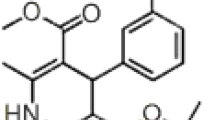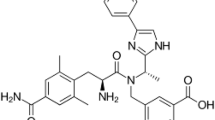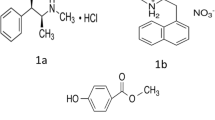Abstract
Six related substances were detected in diosmin bulk drug substances and products by a newly developed gradient reverse-phase high performance liquid chromatography (RP-HPLC) with UV detection. The chromatographic system consisted of an Intersil Wondasil TM ODS (C 18) column (250 × 4.6 mm; 5 μm). The mobile phase consisted of water/acetic acid 66:6 v/v (solvent A) and methanol (solvent B) using a gradient program at a flow rate of 0.8 mL min−1 with 345 nm detection and an injection volume of 20 μL. In addition, the linearity, quantitation limit (QL), accuracy, selectivity, robustness and precision were determined. Good linearity was obtained over the concentration range 0.5–200 μg mL−1 with the coefficient of determination (r 2) of 0.999. The QL was 0.125 μg mL−1 (relative standard deviation <2.0 %). The major impurities have been resolved and identified using two analytical systems, HPLC and HPLC/electrospray ionization-mass spectrometry operated in a negative ion mode. One of these impurities marked as 7-hexopyranosidal diosmetin was unknown and has not been reported previously. Based on mass spectrometry data the structure of the new impurity was proposed as 5-hydroxy-2-(3-hydroxy-4-methoxyphenyl)-4-oxo-4H-chromen-7-yl hexopyranoside. The newly developed RP–LC method for quantitative determination of diosmin-related substances was found to be precise, accurate, robust and specific. It has been successfully employed for the quality evaluation of different sources of raw material and generic formulations of diosmin.





Similar content being viewed by others
References
(2004) Monograph on diosmin. Altern Med Rev 9(3):308–311
Cova D, De Angelis L, Giavarini F, Palladini G, Perego R (1992) Pharmacokinetics and metabolism of oral diosmin in healthy volunteers. Int J Clin Pharmacol Ther Toxicol 30:29–33
Lyseng-Williamson KA, Perry CM (2003) Micronised purified flavonoid fraction: a review of its use in chronic venous insufficiency, venous ulcers and haemorrhoids. Drugs 63:71–100
Jantet G (2002) Chronic venous insufficiency: worldwide results of the RELIEF study. Reflux assessment and quality of life improvement with micronized flavonoids. Angiology 53:245–256
Ramelet AA (2001) Clinical benefits of Daflon 500 mg in the most severe stages of chronic venous insufficiency. Angiology 52:S49–S56
Bergan JJ, Schmid-Schonbein GW, Takase S (2001) Therapeutic approach to chronic venous insufficiency and its complications: place of Daflon 500 mg. Angiology 52:43–47
Lyseng-Williamson KA et al (2003) Micronised purified flavonoids fraction: an examination of its use in incurable venous insufficiency, venous ulcers and haemorrhoids. Drugs 63:71–100
Meshikhes AW (2004) Daflon for haemorrhoids: a prospective, multi-centre observational study. Surgeon 2:335–338
Kecmanovic D et al (2005) PHLEBODIA (diosmine): a purpose in the administration of draining nonprolapsed hemorrhoids. Acta Chir Iugosl 52:115–116
Dimitroulopoulos D, Tsamakidis K, Xinopoulos D et al (2005) Prospective, randomized, controlled, observer-blinded trial of combined infrared photocoagulation and micronized purified flavonoid fraction versus each alone for the treatment of hemorrhoidal disease. Clin Ther 27:746–754
MacKay D (2001) Hemorrhoids and varicose veins: a review of treatment options. Altern Med Rev 6:126–140
Crespo ME, Gálvez J, Cruz T et al (1999) Anti-inflammatory activity of diosmin and hesperidin in rat colitis induced by TNBS. Planta Med 65:651–653
Cypriani B, Limasset B, Carrié ML et al (1993) Antioxidant activity of micronized diosmin on oxygen species from stimulated human neutrophils. Biochem Pharmacol 45:1531–1535
Sherry Torkos (2008) The Canadian Encyclopedia of Natural Medicine. Wiley, New York
Ibegbuna V, Nicolaides AN, Sowade O et al (1997) Venous elasticity after treatment with Daflon 500 mg. Angiology 48:45–49
Pehlivan M et al (2004) The effect of diosmin hesperidin on intestinal ischaemia-reperfusion injury. Acta Chir Belg 104:715
Browning AM et al (2005) Flavonoid glycosides restrain verbal cancer unit proliferation—purpose of mobile uptake and hydrolysis to the aglycones. J Pharm Pharmacol 57:1037–1042
Martinez C et al (2005) Treatment of metastatic cancer B16F10 by the flavonoids tangeretin, rutin, and diosmin. J Agric Food Chem 53:6791–6797
Martinez C et al (2005) The outcome of the flavonoids diosmin, grape seed extract and red booze on the pulmonary metastatic B16F10 melanoma. Histol Histopathol 20:1121–1129
Zhang S, Qin C, Safe SH (2003) Flavonoids as aryl hydrocarbon receptor agonists/antagonists: effects of structure and cell context. Environ Health Perspect 111:1877–1882
Zheng Q, Hirose Y, Yoshimi N (2002) Further investigation of the modifying effect of various chemopreventive agents on apoptosis and cell proliferation in human colon cancer cells. J Cancer Res Clin Oncol 128:539
Rizk Sherine Maher, Sabri Nagwa Ali (2009) Evaluation of clinical activity and safety of Daflon 500 mg in type 2 diabetic female patients. J Saudi Pharm 17:199–207
Manuel Y, Keenoy B, Vertommen J, De Leeuw I (1999) The effect of flavonoid treatment on the glycation and antioxidant status in type 1 diabetic patients. Diabetes Nutr Metab 12:256–263
(1996) ICH guideline for industry, Q3A: impurities in new drug substances, FDA, USA
(1997) ICH guidance for industry, Q3B: impurities in new drug products, FDA, USA
(2008) European Pharmacopoeia, 7th edn. Council of europe, Strasbourg, p 1865
El-Shahawi MS, Bashammakh AS, El-Mogy T (2006) Determination of trace levels of diosmin in a pharmaceutical preparation by adsorptive stripping voltammetry at a glassy carbon electrode. Anal Sci 22:1351
Stalikas CD (2007) Extraction, separation, and detection methods for phenolic acids and flavonoids. J Sep Sci 30(18):3285
Saeidi Iman et al (2011) HPLC determination of hesperidin, diosmin and eriocitrin in Iranian lime juice using polyamide as an adsorbent for solid phase extraction. J Pharm Biomed Anal 56:419–422
El-Shafae AM, El-Domiaty MM (2001) Improved LC methods for the determination of diosmin and/or hesperidin in plant extracts and pharmaceutical formulations. J Pharm Biomed Anal 26:539–545
Campanero MA, Escolar M, Perez G, Garcia-Quetglas E, Sadaba B, Azanza JR (2010) Simultaneous determination of diosmin and diosmetin in human plasma by ion trap liquid chromatography-atmospheric pressure chemical ionization tandem mass spectrometry: application to a clinical pharmacokinetic study. J Pharm Biomed Anal 51:875–881
Kanaze FI et al (2003) Simultaneous reversed-phase high-performance liquid chromatographic method for the determination of diosmin, hesperidin and naringin in different citrus fruit juices and pharmaceutical formulations. J Pharm Biomed Anal 33:243–249
Dugo P, Presti ML, Ohman M, Fazio A, Dugo G, Mondello L (2005) Determination of flavonoids in citrus juices by micro-HPLC–ESI/MS. J Sep Sci 28:1149–1156
Anagnostopoulou Maria A, Kefalas Panagiotis, Kokkalou Eugenios, Assimopoulou Andreana N, Papageorgiou Vassilios P (2005) Analysis of antioxidant compounds in sweet orange peel by HPLC-diode array detection-electrospray ionization mass spectrometry. Biomed Chromatogr 19:138–148
El Bayoumi A (1999) Modified H-point standard addition method and logarithmic function for the spectrophotometric and spectrodensitometric determination of hesperidin and diosmin in mixtures. Anal Lett 32(2):383–400
Janeczko Z, Hubicka U, Krzek J, Podolak I (2003) Qualitative and quantitative analysis of diosmin in tablets by thin-layer chromatography with densitometric UV detection. J Planar Chromatogr 16(5):377–380
Melin A, Perromat A, Deleris G (2001) Fourier-transform infrared spectroscopy: a pharmacotoxicologic tool for in vivo monitoring radical aggression. Can J Physiol Pharmacol 79:158
Bunaciu AA, Udristioiu GE, Ruţă LL, Fleschin Ş, Aboul-Enein HY (2009) Determination of diosmin in pharmaceutical formulations using Fourier transform infrared spectrophotometry. Saudi Pharm J 17(4):303–306
Moldovan Zenovia, Bunaciu Andrei A, Al-Omar Mohammed A, Aboul-Enein Hassan Y (2010) A spectrophotometric method for diosmin determination. Open Chem Biomed Methods J 3:123–127
Zhang Junmei, Wang Junmei, Brodbelt Jennifer S (2005) Characterization of flavonoids by aluminium complexation and collisionally activated dissociation. J Mass Spectrom 40:350–363
Bosch Ojeda C, Sanchez Rojas F (2004) Recent developments in derivative ultraviolet/visible absorption spectrophotometry. Anal Chim Acta 518:1–24
Hvattum Erlend, Ekeberg Dag (2003) Study of the collision-induced radical cleavage of flavonoid glycosides using negative electrospray ionization tandem quadrupole mass spectrometry. J Mass Spectrom 38:43–49
Zhou Yin, Wang Yan, Wang Ren, Guo Fei, Yan Chao (2008) Two-dimensional liquid chromatography coupled with mass spectrometry for the analysis of Lobelia chinensis Lour. Using an ESI/APCI multimode ion source. J Sep Sci 31:2339–2518
Kanaze Feras Imad, Bounartzi Melpomeni I, Niopas Ioannis (2004) A validated HPLC determination of the flavone aglycone diosmetin in human plasma. Biomed Chromatogr 18:800–804
Shabir GA (2003) Validation of high-performance liquid chromatography methods for pharmaceutical analysis. Understanding the differences and similarities between validation requirements of the US food and drug administration, the US pharmacopeia and the international conference on harmonization. J Chromatogr A 987:57–66
Ribani M, Bottoli CBG, Collins CH, Jardim ISF, Melo LFC (2004) Validation for chromatographic and electrophoretic methods. Quím Nova 27(5):771–780
USP (2000) Validation of compendial methods, 24th edn. The United States Pharmacopeia (USP 24, section 1225)
CDER (1994) Reviewer guidance validation of chromatographic methods, Centre for Drug Evaluation and Research (CDER), FDA, USA
Katsenis Konstantinos (2005) Micronized purified flavonoid fraction (MPFF): a review of its pharmacological effects, therapeutic efficacy and benefits in the management of chronic venous insufficiency. Curr Vasc Pharmacol 3:1–9
Acknowledgments
The authors would like to thank Chengdu Runde Pharmaceutical Co., Ltd (China) for the supply of raw material of diosmin and Chiatai Tianqing Co., Ltd (Nanjing, China) for the supply of drug tablets. All colleagues are also acknowledged for support and constant encouragement.
Author information
Authors and Affiliations
Corresponding author
Rights and permissions
About this article
Cite this article
Adouani, I., Du, M. & Hang, TJ. Identification and Determination of Related Substances in Diosmin Bulk Drug and Pharmaceutical Formulations by HPLC and HPLC–MS. Chromatographia 76, 499–508 (2013). https://doi.org/10.1007/s10337-013-2404-z
Received:
Revised:
Accepted:
Published:
Issue Date:
DOI: https://doi.org/10.1007/s10337-013-2404-z




